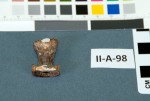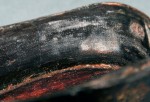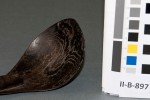Under Construction, August 2011
1. BACKGROUND
Many Alaska Native cultures have used bone, tooth, ivory and antler extensively in their tools, fishing and hunting gear, ornaments, and other items. Some of these materials may look similar if they come from an archaeological setting. Marine mammals provided materials common to Alaska but not widely seen in many other places, such as whale vertebrae and walrus tusk ivory. Mammoth and mastodon ivory is also sometimes seen made into artifacts. Beware, material called “whalebone” is sometimes actually referring to baleen, the filtering mouth parts of certain whales. This material looks a bit like black or brown plastic and was widely used as corset stays, for example. It is made of the protein keratin and is not actually bone at all.
2. POSSIBLE CAUSES
The most common white stuff we have seen on Alaskan bone, tooth, ivory and antler is related to exhibition or repair, such as adhesives and putties. Burned bone, tooth, ivory or antler may be “calcined” or oxidized by heating which can cause a white powdery or crusty material. Sometimes, in the case of archaeological material for example, darker surfaces chip off or abrade away and reveal lighter white-looking areas below. This is most commonly seen on antler from archaeological contexts. The walrus tusk container seen in the image below has “white stuff” in the incised lines of the carving. The records suggest the artifact came from an archaeological context on St Lawrence Island and was sold to the Museum by a resident many years ago. The white material may have been rubbed into the incised lines at that time to help highlight the design.
3. REFERENCES
Johnson, Jessica S. “Consolidation of Archaeological Bone: A Conservation Perspective.” Jourbal of Field Archaeology. Vol. 21, 1994.
Ellen Carrlee’s notes: Explores consolidants used by conservators in the mid 1990’s (many of which are still used) to consolidate bone, including acrylic resins Acryloid B-72, water based acrylic colloidal dispersion Acrysol WS-24, water based acrylic emulsion such as Rhoplex AC-33, poly(vinyl) acetate resin such as AYAA or AYAF, poly(vinyl) butyral resin Butvar B-98. Also describes consolidants that have been used in the past but are not now recommended, such as “white glue” polyvinyl acetate emulsion (Elmer’s Glue, Carpenter’s Glue), wax, shellac, cellulose nitrate (marketed as Duco or Ambroid), gum dammar, gum Arabic, polyethylene glycol (PEG or Carbowax), agar jelly, ethylhydrohyethycellulose, poly(vinyl) acetate emulsion (Vinamul or Gelva), poly(vinyl) acetate resin (Vinylite or Gelva), epoxy, cyanoacrylate “crazy glue” (marketed today as Paleobond, for example, and known to be used in Alaska).
Koob, Stephen P. (1984) “The Consolidation of Archaeological Bone.” Adhesives and Consolidants. Preprints of the Contributions to the IIC Paris Congress, 2-8 september 1984 London. pp. 98-102.
4. EXAMPLES IN ALASKA



















